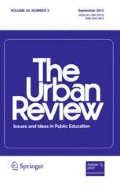Abstract
There is a distinct class difference in the way that children are taught school behavior. Teachers in affluent schools use more implicit teaching techniques while teachers of low-income children are more explicit in their teaching of behavior. This stems largely from the alignment of the home culture of middle class children to school behavior and the difference between the home culture of low-income children to school codes. However, middle class children learn behavior at home implicitly. This study examines the possibility of low-income children learning school behavior implicitly while at school. The researcher observed two Chicago Head Start centers—one using implicit instruction and one teaching behavior explicitly—over a period of 5 months. Observational data showed that the children that learned school behavior through implicit teaching techniques better internalized school behavior and, by extension, middle class codes.
Similar content being viewed by others
Notes
The ability to delay gratification and having a future orientation, while important middle class codes, are not developmentally appropriate for the age of the children in this study.
I was assigned to the sites by their managing agencies. Unfortunately, as I was placed where it was most convenient for the agency, I was not able to match the two populations for race. However, both populations are of racial/ethnic groups that have a history of discrimination and have had great difficulty moving into higher socio-economic levels.
References
Bereiter, C., & Engelmann, S. (1966). Teaching disadvantaged children in the preschool. Englewood Cliffs, NJ: Prentice-Hall, Inc.
Bernstein, B. (1971). On the classification and framing of educational knowledge. In B. Bernstein (Ed.), Class, codes and control (Vol. 1, pp. 202–230). London: Routledge & Kegan Paul Ltd.
Bernstein, B. (1975). Class and Pedagogies: Visible and Invisible. In B. Bernstein (Ed.), Class, codes and control (Vol. 3, pp. 116–145). Lanham, MD: Routledge & Kegan Paul Ltd.
Bondy, E., & Ross, D. D. (2008). The teacher as warm demander. Educational Leadership, 66(1), 54–58.
Bondy, E., Ross, D. D., Gallingane, C., & Hambacher, E. (2007). Creating environments of success and resilience: Culturally responsive classroom management and more. Urban Education, 42(4), 326–348.
Borstelmann, L. J. (1967). Proceedings from the Northern Ireland branch of the British Psychological Society. The Culturally Disadvantaged and Compensatory Education: Fantasies and Realities. Belfast, Northern Ireland.
Boyd, W. L. (1991). What makes Ghetto schools succeed or fail? Teachers College Record, 92(3), 331–362.
Chapman, T. K. (2004). Foundations of multicultural education: Marcus Garvey and the United Negro improvement association. The Journal of Negro Education, 73(4), 4424–4434.
Delpit, L. (2006). Other people’s children: Cultural conflict in the classroom. New York: The New Press.
Freire, P. (2000). Pedagogy of the oppressed. New York: Continuum International Publishing Group Inc.
Getzels, J. W. (1966). Pre-school education. Teachers College Record, 68(3), 219–228.
Haberman, M. (n.d.) The Pedagogy of poverty versus good teaching. Retrieved August 28, 2009 from homepages.wmich.edu/~ljohnson/Haberman.pdf.
Heath, S. B. (1983). Ways with words. Cambridge: Cambridge University Press.
Johnson, K. R. (1966). Teaching culturally disadvantaged pupils (Grades K-3): Unit III: The culturally.
Lareau, A. (2003). Unequal childhoods: Class, race, and family life. Berkeley, CA: University of California Press.
Morais, A. M. (2002). Basil Bernstein at the micro level of the classroom. British Journal of Sociology of Education, 23(4), 559–569.
Piuck, C. L. (1975). Child-rearing patterns of poverty. American Journal of Psychotherapy, 29(4), 485–502.
Price, K. (1967). The problem of the culturally deprived. Teachers College Record, 69(2), 123–131.
Sadovnik, A. R. (2007). Schools, social class, and youth: A Bernsteinian analysis. In L. Weiss (Ed.), The way class works: Readings on school, family, and the economy (pp. 316–328). London: Taylor & Francis Group.
Ware, F. (2006). Warm demander pedagogy: Culturally responsive teaching that supports a culture of achievement for African American students. Urban Education, 41(4), 427–456.
Weinstein, C., Curran, M., & Tomlinson-Clarke, S. (2003). Culturally responsive classroom management: Awareness into action. Theory Into Practice, 42, 269–276.
Author information
Authors and Affiliations
Corresponding author
Rights and permissions
About this article
Cite this article
Smith, S.C. Cultural Relay in Early Childhood Education: Methods of Teaching School Behavior to Low-Income Children. Urban Rev 44, 571–588 (2012). https://doi.org/10.1007/s11256-012-0205-6
Published:
Issue Date:
DOI: https://doi.org/10.1007/s11256-012-0205-6




